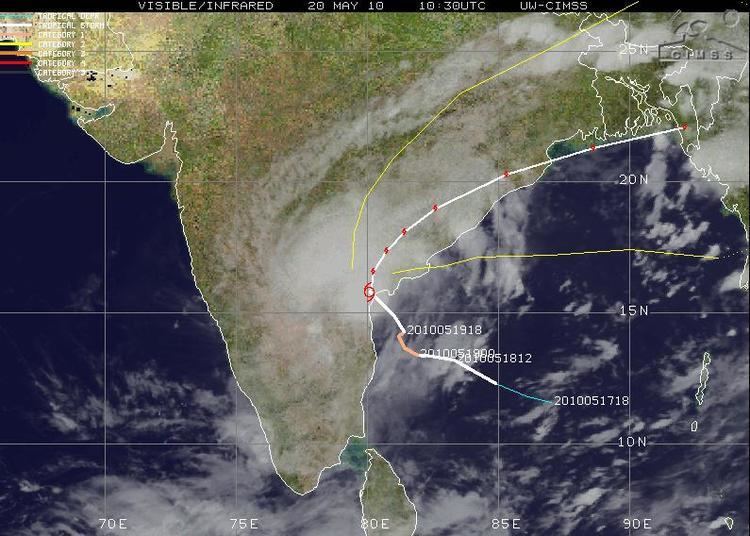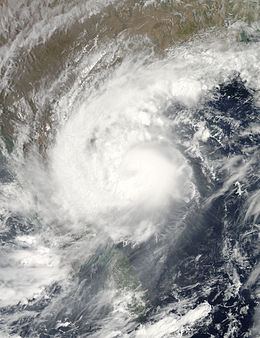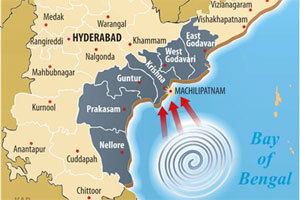Formed May 17, 2010 Fatalities 65 total | Dissipated May 21, 2010 Date 17 May 2010 – 21 May 2010 | |
 | ||
Highest winds 3-minute sustained: 100 km/h (65 mph)1-minute sustained: 120 km/h (75 mph) Lowest pressure 986 hPa (mbar); 29.12 inHg Damage $117.49 million (2010 USD) Similar Cyclone Jal, Cyclone Nisha, Cyclone Thane, Cyclone Nilam, Cyclone Phyan | ||
Tropical cyclone laila strikes india 2010 05 19
Cyclonic Storm Laila (IMD designation:BOB 01, JTWC designation:01B) was the first cyclonic storm to affect southeastern India in May since the 1990 Andhra Pradesh cyclone. The first tropical cyclone of the 2010 North Indian Ocean cyclone season, Laila developed on May 17 in the Bay of Bengal from a persistent area of convection. Strengthening as it tracked northwestward, it became a severe cyclonic storm on May 19. The next day, Laila made landfall in Andhra Pradesh, and it later dissipated over land. It caused flooding and damage along its path. Laila is an Urdu/Arabic name, meaning Night. It was the worst storm to hit Andhra Pradesh in the last 14 years.
Contents
- Tropical cyclone laila strikes india 2010 05 19
- Ongole cyclone laila effect
- Meteorological history
- Sri Lanka
- Tamil Nadu
- Andhra Pradesh
- References
Ongole cyclone laila effect
Meteorological history

In the middle of May 2010, an area of convection, or thunderstorms, persisted about 865 miles (1400 km) south of the Indian city of Kolkata (formerly Calcutta) in the Bay of Bengal. It was initially disorganized, although satellite imagery indicated a mid-level circulation. After a few days, the convection began consolidating around a developing low-level circulation, and rainbands became evident. With low amounts of wind shear in the region, the Joint Typhoon Warning Center (JTWC) assessed its chances of development as fair. The official warning agency in the basin – the India Meteorological Department (IMD) – classified the system as Depression BOB 001 at 0900 UTC on May 17. About three hours after the depression was first classified, the IMD upgraded the system to a deep depression, indicating sustained winds of at least 34 mph (55 km/h).

Late on May 17, the JTWC classified the system as Tropical Cyclone 01B, based on further organization. By that time, it was located about 485 miles (780 km) east-southeast of Chennai, Tamil Nadu, and was moving westward due to its position southwest of the subtropical ridge. The IMD upgraded the deep depression to Cyclonic Storm Laila early on May 18. With further consolidation of the convection throughout the day, the JTWC noted that the storm "[appeared] to be rapidly intensifying", which is a term referring to a quick drop in barometric pressure that usually coincides with a sharp increase in winds. By late on May 18, an eye feature became evident on satellite imagery, and at 0000 UTC on May 19, the JTWC assessed Laila as producing peak winds of 75 mph (120 km/h), the equivalent of a minimal hurricane. A few hours later, the IMD upgraded Laila to a severe cyclonic storm.

After reaching peak intensity, Laila briefly decelerated as it moved around tan increasing, and the cyclone began weakening as it remained just off the coast. Between 1100 and 1200 UTC on May 20, Laila made landfall near Bapatla, Andhra Pradesh.
Sri Lanka
Cyclone Laila displaced nearly 280,000 people, triggering floods, delaying flights and submerging many areas of capital Colombo. The indirect impact of the cyclone was compounded as heavy pre-monsoonal showers set in over parts of the country as the storm developed over the Bay of Bengal. The Sri Lanka air force helicopters and navy vessels were pressed into service to ferry stranded passengers from Colombo to the international airport after parts of the connecting roads were washed away. All international and domestic flights were either delayed or cancelled because of heavy rain. Colombo experienced 350 mm of rain over the last five days ending May 20. Sri Lanka's Disaster Management Center has reported that 513,586 from 118,888 families have been affected and 20 people had died by this evening due to the devastating floods caused by incessant torrential rain. A United Nations assessment team visited the flood affected areas in Kalutara district on May 20 to evaluate the situation. The team visited the Gampaha district and met the relevant officials to coordinate relief efforts. According to the Met Department, the prevailing unusual weather pattern was caused by the activation of the South-Western monsoon period on top of the feeder bands of Cyclone Leila moving over the island.
Thousands of passengers were also stranded after railway tracks were flooded across the country. Several train stations had to suspend operations. The Lankan Parliament, located in a Colombo suburb, was adjourned after an adjoining lake threatened to overflow and flood the premises. The weather conditions experienced were caused after Sri Lanka was hit by 'feeder bands' (clouds on the outer spirals of a cyclone but connected to its centre) of the cyclone as it moved up the Indian east coast.
Tamil Nadu
Nine people were killed in rain related incidents in Tamil Nadu, as the cyclonic storm "Laila" battered the Coastal areas in Northern parts of Tamil Nadu, Chennai city and its suburbs. Several fishermen, who put out to sea in 100 boats were reported missing since May 17, according to fisheries department sources. The fishermen of Pamban, Uchipuli and nearby areas who ventured into sea on May 17 night in boats with outboard motors were missing.
Andhra Pradesh
The death toll of the cyclone-related incidents rose to 36 on Friday with 12 more deaths reported from Krishna (4), Guntur (3), Vizag (3) and Prakasam (2) districts. Several persons were reported missing from the worst-hit coastal districts. More than 170 houses were completely destroyed and 265 suffered partial damage while 367 livestock perished in the cyclone.
Early in the duration of the cyclone, the IMD noted the potential for heavy rainfall and gusty winds along the coast of Andhra Pradesh. The agency advised fishermen to avoid being in open seas. Additionally, the agency contacted state governments in the region to warn of the storm's threat. The weather office has stated that the cyclone will not have an effect on the monsoon season.
Cyclone Laila battered Ongole town; it received heavy rain of 320 mm on May 20 and 142 mm on May 21, and has made rivulets like Gundlakamma, Addavagu and Pothurajukalva swollen. Addanki received the highest rainfall of 522 mm, followed by Maddipadu with 510 mm and Kothapatnam 258 mm in 24 hours on May 21.
The cyclone caused heavy destruction in Prakasam, Krishna and Guntur districts and preliminary reports prepared by the State government put the loss at over Rs 500 crore. According to a BBC report, Cyclone Laila was the worst storm to hit Andhra Pradesh in 14 years.
